BSBINN601: Fast Track Couriers - Change Management Report
VerifiedAdded on 2022/11/01
|12
|2571
|256
Report
AI Summary
This report presents a comprehensive change management strategy for Fast Track Couriers, focusing on the company's expansion into smaller package deliveries. It begins with an introduction to the company's current state, analyzing its objectives related to people, policy, technology, and organizational structure. The report identifies the impact of external trends, such as the rising demand for faster delivery times and the rapid expansion of the service sector, on the company's strategic goals. It details change requirements across human resourcing, strategic planning, and operational plans, addressing performance gaps, business opportunities, and market threats. The report then discusses the people involved in the change process, emphasizing the need for a continuous consulting model and the identification of internal stakeholders. A detailed cost-benefit analysis is provided, evaluating both non-recurring and recurring costs alongside anticipated benefits. Furthermore, a risk analysis identifies potential barriers and proposes mitigation strategies. The report concludes with a discussion of categorized changes and provides references to support the analysis, offering a practical framework for leading and managing organizational change within Fast Track Couriers.
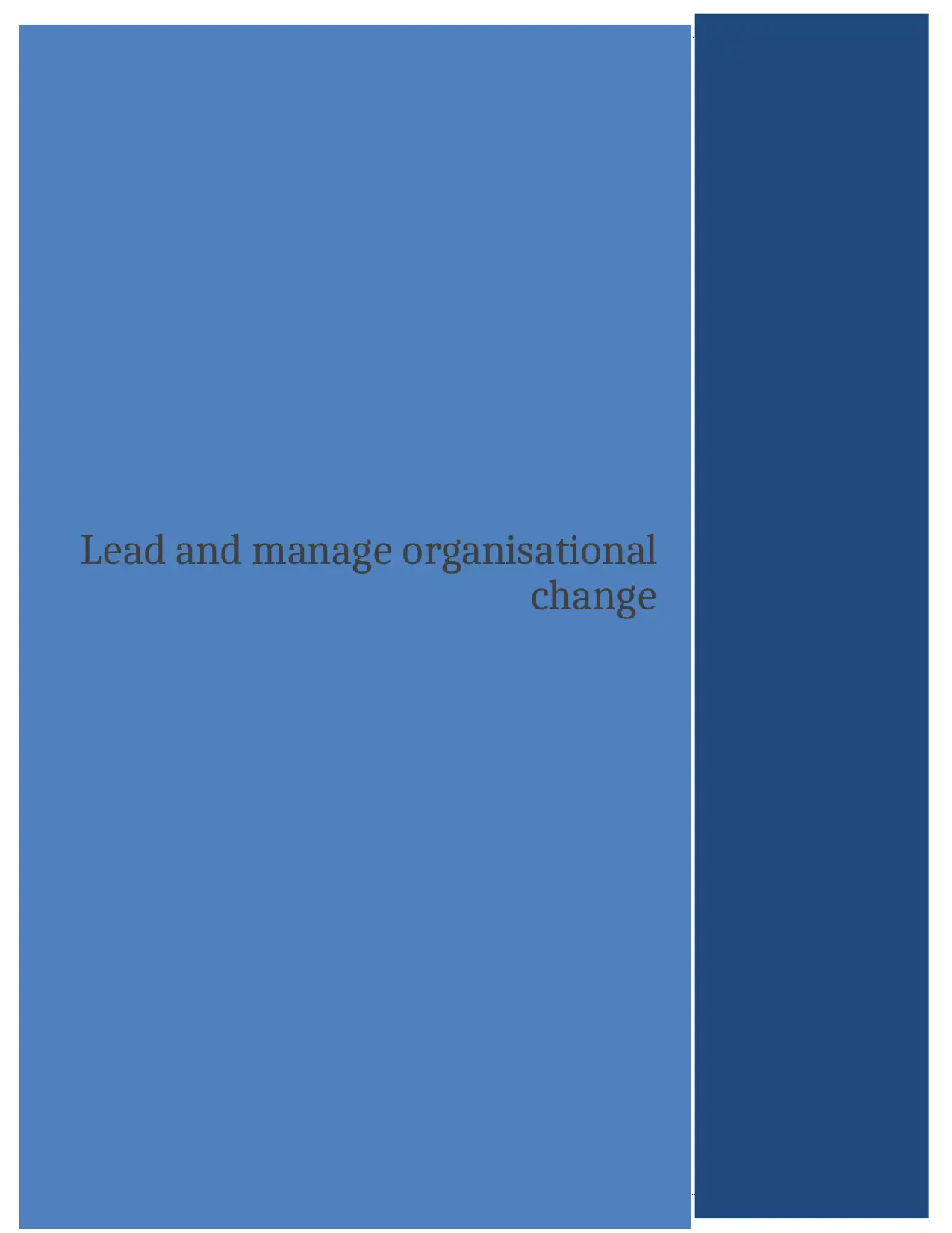
1
Lead and manage organizational change
Lead and manage organisational
change
Lead and manage organizational change
Lead and manage organisational
change
Paraphrase This Document
Need a fresh take? Get an instant paraphrase of this document with our AI Paraphraser
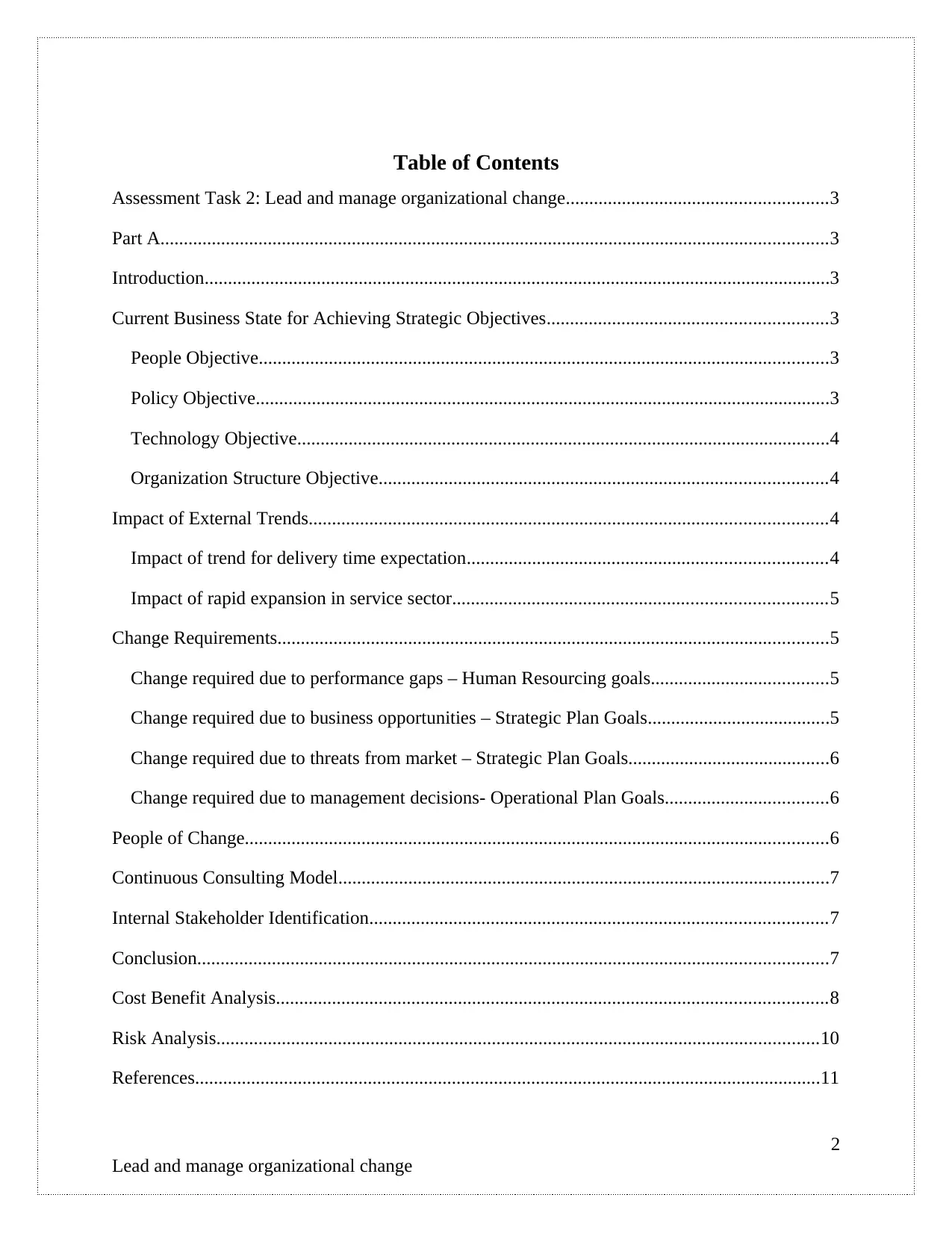
Table of Contents
Assessment Task 2: Lead and manage organizational change........................................................3
Part A...............................................................................................................................................3
Introduction......................................................................................................................................3
Current Business State for Achieving Strategic Objectives............................................................3
People Objective..........................................................................................................................3
Policy Objective...........................................................................................................................3
Technology Objective..................................................................................................................4
Organization Structure Objective................................................................................................4
Impact of External Trends...............................................................................................................4
Impact of trend for delivery time expectation.............................................................................4
Impact of rapid expansion in service sector................................................................................5
Change Requirements......................................................................................................................5
Change required due to performance gaps – Human Resourcing goals......................................5
Change required due to business opportunities – Strategic Plan Goals.......................................5
Change required due to threats from market – Strategic Plan Goals...........................................6
Change required due to management decisions- Operational Plan Goals...................................6
People of Change.............................................................................................................................6
Continuous Consulting Model.........................................................................................................7
Internal Stakeholder Identification..................................................................................................7
Conclusion.......................................................................................................................................7
Cost Benefit Analysis......................................................................................................................8
Risk Analysis.................................................................................................................................10
References......................................................................................................................................11
2
Lead and manage organizational change
Assessment Task 2: Lead and manage organizational change........................................................3
Part A...............................................................................................................................................3
Introduction......................................................................................................................................3
Current Business State for Achieving Strategic Objectives............................................................3
People Objective..........................................................................................................................3
Policy Objective...........................................................................................................................3
Technology Objective..................................................................................................................4
Organization Structure Objective................................................................................................4
Impact of External Trends...............................................................................................................4
Impact of trend for delivery time expectation.............................................................................4
Impact of rapid expansion in service sector................................................................................5
Change Requirements......................................................................................................................5
Change required due to performance gaps – Human Resourcing goals......................................5
Change required due to business opportunities – Strategic Plan Goals.......................................5
Change required due to threats from market – Strategic Plan Goals...........................................6
Change required due to management decisions- Operational Plan Goals...................................6
People of Change.............................................................................................................................6
Continuous Consulting Model.........................................................................................................7
Internal Stakeholder Identification..................................................................................................7
Conclusion.......................................................................................................................................7
Cost Benefit Analysis......................................................................................................................8
Risk Analysis.................................................................................................................................10
References......................................................................................................................................11
2
Lead and manage organizational change
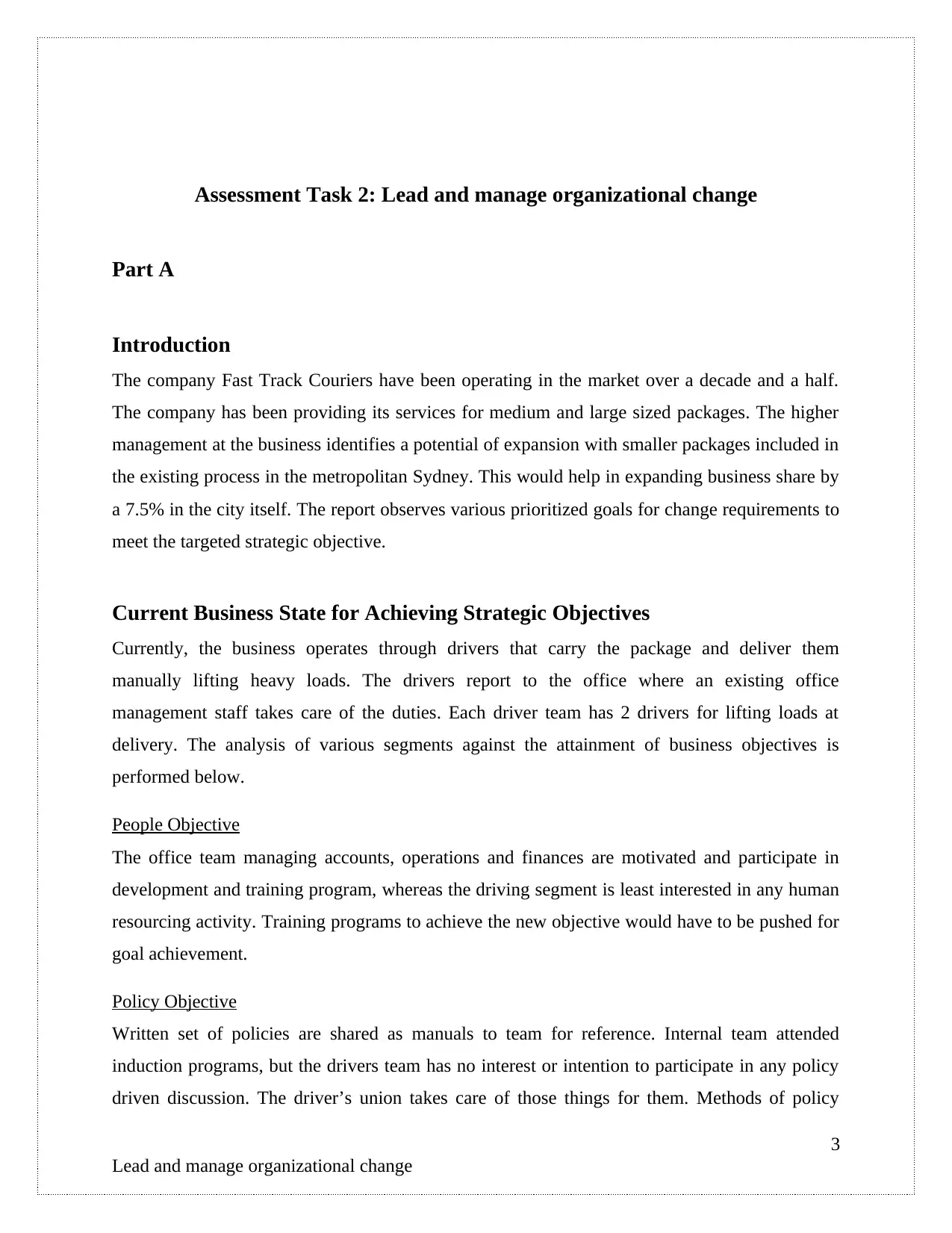
Assessment Task 2: Lead and manage organizational change
Part A
Introduction
The company Fast Track Couriers have been operating in the market over a decade and a half.
The company has been providing its services for medium and large sized packages. The higher
management at the business identifies a potential of expansion with smaller packages included in
the existing process in the metropolitan Sydney. This would help in expanding business share by
a 7.5% in the city itself. The report observes various prioritized goals for change requirements to
meet the targeted strategic objective.
Current Business State for Achieving Strategic Objectives
Currently, the business operates through drivers that carry the package and deliver them
manually lifting heavy loads. The drivers report to the office where an existing office
management staff takes care of the duties. Each driver team has 2 drivers for lifting loads at
delivery. The analysis of various segments against the attainment of business objectives is
performed below.
People Objective
The office team managing accounts, operations and finances are motivated and participate in
development and training program, whereas the driving segment is least interested in any human
resourcing activity. Training programs to achieve the new objective would have to be pushed for
goal achievement.
Policy Objective
Written set of policies are shared as manuals to team for reference. Internal team attended
induction programs, but the drivers team has no interest or intention to participate in any policy
driven discussion. The driver’s union takes care of those things for them. Methods of policy
3
Lead and manage organizational change
Part A
Introduction
The company Fast Track Couriers have been operating in the market over a decade and a half.
The company has been providing its services for medium and large sized packages. The higher
management at the business identifies a potential of expansion with smaller packages included in
the existing process in the metropolitan Sydney. This would help in expanding business share by
a 7.5% in the city itself. The report observes various prioritized goals for change requirements to
meet the targeted strategic objective.
Current Business State for Achieving Strategic Objectives
Currently, the business operates through drivers that carry the package and deliver them
manually lifting heavy loads. The drivers report to the office where an existing office
management staff takes care of the duties. Each driver team has 2 drivers for lifting loads at
delivery. The analysis of various segments against the attainment of business objectives is
performed below.
People Objective
The office team managing accounts, operations and finances are motivated and participate in
development and training program, whereas the driving segment is least interested in any human
resourcing activity. Training programs to achieve the new objective would have to be pushed for
goal achievement.
Policy Objective
Written set of policies are shared as manuals to team for reference. Internal team attended
induction programs, but the drivers team has no interest or intention to participate in any policy
driven discussion. The driver’s union takes care of those things for them. Methods of policy
3
Lead and manage organizational change
⊘ This is a preview!⊘
Do you want full access?
Subscribe today to unlock all pages.

Trusted by 1+ million students worldwide
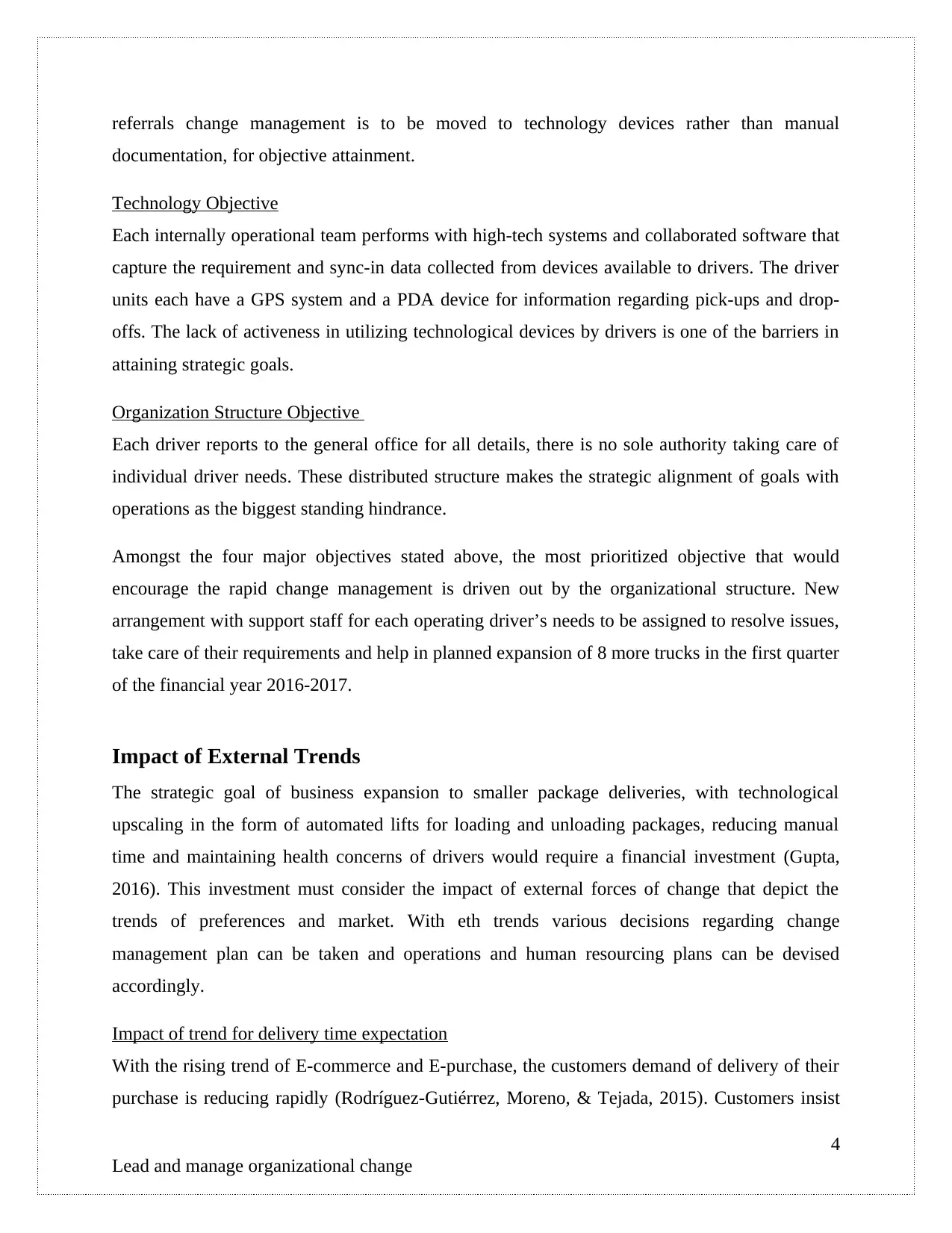
referrals change management is to be moved to technology devices rather than manual
documentation, for objective attainment.
Technology Objective
Each internally operational team performs with high-tech systems and collaborated software that
capture the requirement and sync-in data collected from devices available to drivers. The driver
units each have a GPS system and a PDA device for information regarding pick-ups and drop-
offs. The lack of activeness in utilizing technological devices by drivers is one of the barriers in
attaining strategic goals.
Organization Structure Objective
Each driver reports to the general office for all details, there is no sole authority taking care of
individual driver needs. These distributed structure makes the strategic alignment of goals with
operations as the biggest standing hindrance.
Amongst the four major objectives stated above, the most prioritized objective that would
encourage the rapid change management is driven out by the organizational structure. New
arrangement with support staff for each operating driver’s needs to be assigned to resolve issues,
take care of their requirements and help in planned expansion of 8 more trucks in the first quarter
of the financial year 2016-2017.
Impact of External Trends
The strategic goal of business expansion to smaller package deliveries, with technological
upscaling in the form of automated lifts for loading and unloading packages, reducing manual
time and maintaining health concerns of drivers would require a financial investment (Gupta,
2016). This investment must consider the impact of external forces of change that depict the
trends of preferences and market. With eth trends various decisions regarding change
management plan can be taken and operations and human resourcing plans can be devised
accordingly.
Impact of trend for delivery time expectation
With the rising trend of E-commerce and E-purchase, the customers demand of delivery of their
purchase is reducing rapidly (Rodríguez-Gutiérrez, Moreno, & Tejada, 2015). Customers insist
4
Lead and manage organizational change
documentation, for objective attainment.
Technology Objective
Each internally operational team performs with high-tech systems and collaborated software that
capture the requirement and sync-in data collected from devices available to drivers. The driver
units each have a GPS system and a PDA device for information regarding pick-ups and drop-
offs. The lack of activeness in utilizing technological devices by drivers is one of the barriers in
attaining strategic goals.
Organization Structure Objective
Each driver reports to the general office for all details, there is no sole authority taking care of
individual driver needs. These distributed structure makes the strategic alignment of goals with
operations as the biggest standing hindrance.
Amongst the four major objectives stated above, the most prioritized objective that would
encourage the rapid change management is driven out by the organizational structure. New
arrangement with support staff for each operating driver’s needs to be assigned to resolve issues,
take care of their requirements and help in planned expansion of 8 more trucks in the first quarter
of the financial year 2016-2017.
Impact of External Trends
The strategic goal of business expansion to smaller package deliveries, with technological
upscaling in the form of automated lifts for loading and unloading packages, reducing manual
time and maintaining health concerns of drivers would require a financial investment (Gupta,
2016). This investment must consider the impact of external forces of change that depict the
trends of preferences and market. With eth trends various decisions regarding change
management plan can be taken and operations and human resourcing plans can be devised
accordingly.
Impact of trend for delivery time expectation
With the rising trend of E-commerce and E-purchase, the customers demand of delivery of their
purchase is reducing rapidly (Rodríguez-Gutiérrez, Moreno, & Tejada, 2015). Customers insist
4
Lead and manage organizational change
Paraphrase This Document
Need a fresh take? Get an instant paraphrase of this document with our AI Paraphraser
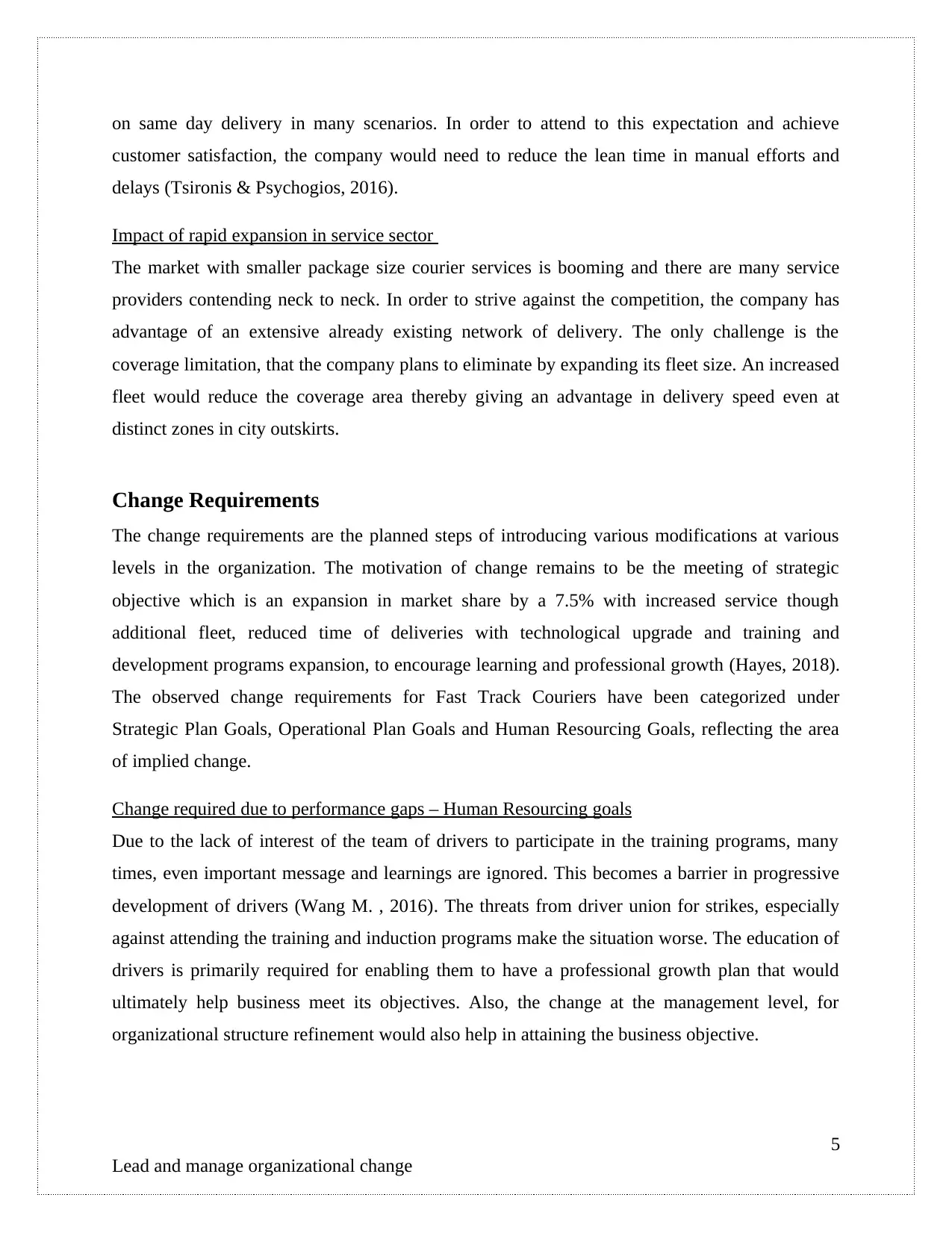
on same day delivery in many scenarios. In order to attend to this expectation and achieve
customer satisfaction, the company would need to reduce the lean time in manual efforts and
delays (Tsironis & Psychogios, 2016).
Impact of rapid expansion in service sector
The market with smaller package size courier services is booming and there are many service
providers contending neck to neck. In order to strive against the competition, the company has
advantage of an extensive already existing network of delivery. The only challenge is the
coverage limitation, that the company plans to eliminate by expanding its fleet size. An increased
fleet would reduce the coverage area thereby giving an advantage in delivery speed even at
distinct zones in city outskirts.
Change Requirements
The change requirements are the planned steps of introducing various modifications at various
levels in the organization. The motivation of change remains to be the meeting of strategic
objective which is an expansion in market share by a 7.5% with increased service though
additional fleet, reduced time of deliveries with technological upgrade and training and
development programs expansion, to encourage learning and professional growth (Hayes, 2018).
The observed change requirements for Fast Track Couriers have been categorized under
Strategic Plan Goals, Operational Plan Goals and Human Resourcing Goals, reflecting the area
of implied change.
Change required due to performance gaps – Human Resourcing goals
Due to the lack of interest of the team of drivers to participate in the training programs, many
times, even important message and learnings are ignored. This becomes a barrier in progressive
development of drivers (Wang M. , 2016). The threats from driver union for strikes, especially
against attending the training and induction programs make the situation worse. The education of
drivers is primarily required for enabling them to have a professional growth plan that would
ultimately help business meet its objectives. Also, the change at the management level, for
organizational structure refinement would also help in attaining the business objective.
5
Lead and manage organizational change
customer satisfaction, the company would need to reduce the lean time in manual efforts and
delays (Tsironis & Psychogios, 2016).
Impact of rapid expansion in service sector
The market with smaller package size courier services is booming and there are many service
providers contending neck to neck. In order to strive against the competition, the company has
advantage of an extensive already existing network of delivery. The only challenge is the
coverage limitation, that the company plans to eliminate by expanding its fleet size. An increased
fleet would reduce the coverage area thereby giving an advantage in delivery speed even at
distinct zones in city outskirts.
Change Requirements
The change requirements are the planned steps of introducing various modifications at various
levels in the organization. The motivation of change remains to be the meeting of strategic
objective which is an expansion in market share by a 7.5% with increased service though
additional fleet, reduced time of deliveries with technological upgrade and training and
development programs expansion, to encourage learning and professional growth (Hayes, 2018).
The observed change requirements for Fast Track Couriers have been categorized under
Strategic Plan Goals, Operational Plan Goals and Human Resourcing Goals, reflecting the area
of implied change.
Change required due to performance gaps – Human Resourcing goals
Due to the lack of interest of the team of drivers to participate in the training programs, many
times, even important message and learnings are ignored. This becomes a barrier in progressive
development of drivers (Wang M. , 2016). The threats from driver union for strikes, especially
against attending the training and induction programs make the situation worse. The education of
drivers is primarily required for enabling them to have a professional growth plan that would
ultimately help business meet its objectives. Also, the change at the management level, for
organizational structure refinement would also help in attaining the business objective.
5
Lead and manage organizational change
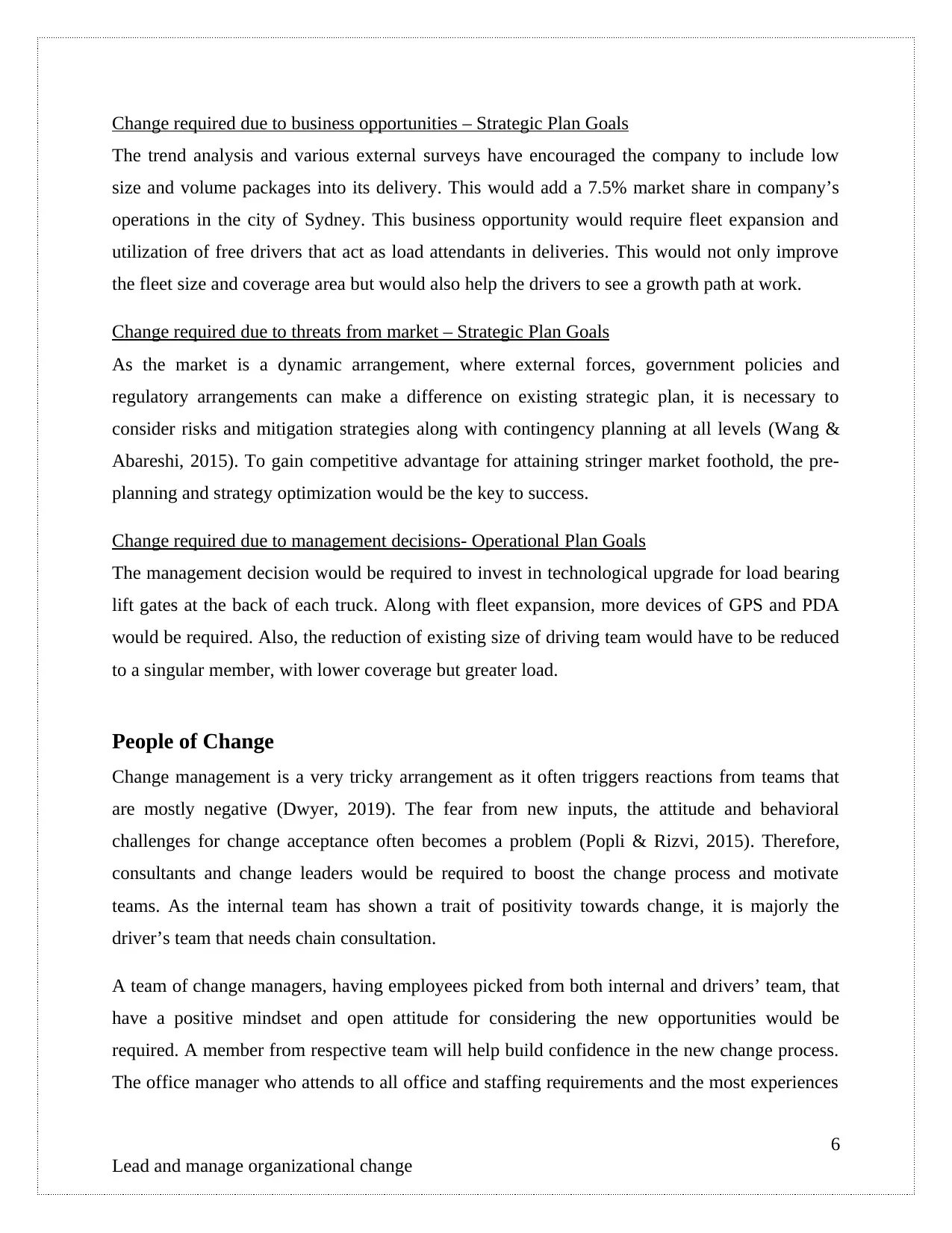
Change required due to business opportunities – Strategic Plan Goals
The trend analysis and various external surveys have encouraged the company to include low
size and volume packages into its delivery. This would add a 7.5% market share in company’s
operations in the city of Sydney. This business opportunity would require fleet expansion and
utilization of free drivers that act as load attendants in deliveries. This would not only improve
the fleet size and coverage area but would also help the drivers to see a growth path at work.
Change required due to threats from market – Strategic Plan Goals
As the market is a dynamic arrangement, where external forces, government policies and
regulatory arrangements can make a difference on existing strategic plan, it is necessary to
consider risks and mitigation strategies along with contingency planning at all levels (Wang &
Abareshi, 2015). To gain competitive advantage for attaining stringer market foothold, the pre-
planning and strategy optimization would be the key to success.
Change required due to management decisions- Operational Plan Goals
The management decision would be required to invest in technological upgrade for load bearing
lift gates at the back of each truck. Along with fleet expansion, more devices of GPS and PDA
would be required. Also, the reduction of existing size of driving team would have to be reduced
to a singular member, with lower coverage but greater load.
People of Change
Change management is a very tricky arrangement as it often triggers reactions from teams that
are mostly negative (Dwyer, 2019). The fear from new inputs, the attitude and behavioral
challenges for change acceptance often becomes a problem (Popli & Rizvi, 2015). Therefore,
consultants and change leaders would be required to boost the change process and motivate
teams. As the internal team has shown a trait of positivity towards change, it is majorly the
driver’s team that needs chain consultation.
A team of change managers, having employees picked from both internal and drivers’ team, that
have a positive mindset and open attitude for considering the new opportunities would be
required. A member from respective team will help build confidence in the new change process.
The office manager who attends to all office and staffing requirements and the most experiences
6
Lead and manage organizational change
The trend analysis and various external surveys have encouraged the company to include low
size and volume packages into its delivery. This would add a 7.5% market share in company’s
operations in the city of Sydney. This business opportunity would require fleet expansion and
utilization of free drivers that act as load attendants in deliveries. This would not only improve
the fleet size and coverage area but would also help the drivers to see a growth path at work.
Change required due to threats from market – Strategic Plan Goals
As the market is a dynamic arrangement, where external forces, government policies and
regulatory arrangements can make a difference on existing strategic plan, it is necessary to
consider risks and mitigation strategies along with contingency planning at all levels (Wang &
Abareshi, 2015). To gain competitive advantage for attaining stringer market foothold, the pre-
planning and strategy optimization would be the key to success.
Change required due to management decisions- Operational Plan Goals
The management decision would be required to invest in technological upgrade for load bearing
lift gates at the back of each truck. Along with fleet expansion, more devices of GPS and PDA
would be required. Also, the reduction of existing size of driving team would have to be reduced
to a singular member, with lower coverage but greater load.
People of Change
Change management is a very tricky arrangement as it often triggers reactions from teams that
are mostly negative (Dwyer, 2019). The fear from new inputs, the attitude and behavioral
challenges for change acceptance often becomes a problem (Popli & Rizvi, 2015). Therefore,
consultants and change leaders would be required to boost the change process and motivate
teams. As the internal team has shown a trait of positivity towards change, it is majorly the
driver’s team that needs chain consultation.
A team of change managers, having employees picked from both internal and drivers’ team, that
have a positive mindset and open attitude for considering the new opportunities would be
required. A member from respective team will help build confidence in the new change process.
The office manager who attends to all office and staffing requirements and the most experiences
6
Lead and manage organizational change
⊘ This is a preview!⊘
Do you want full access?
Subscribe today to unlock all pages.

Trusted by 1+ million students worldwide
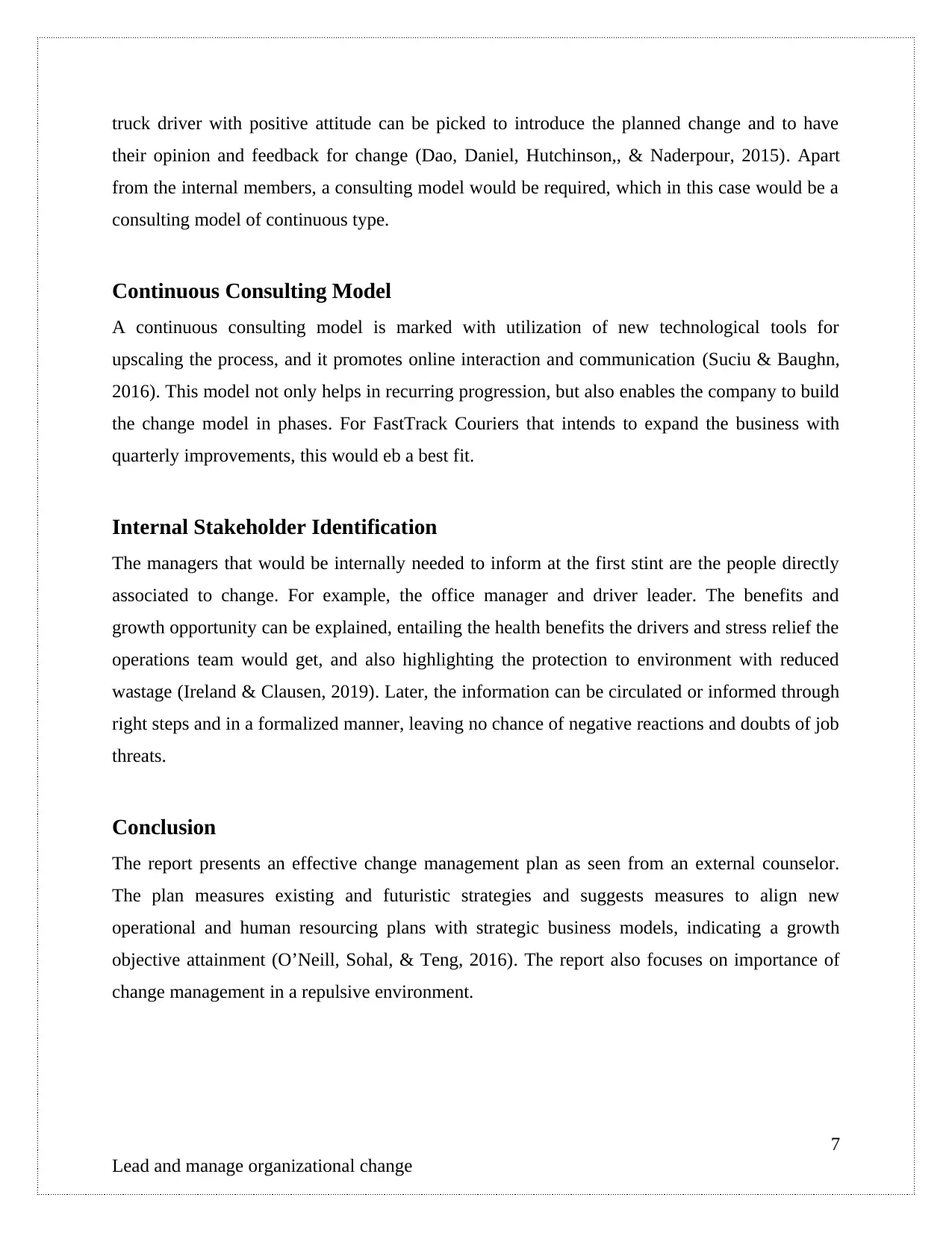
truck driver with positive attitude can be picked to introduce the planned change and to have
their opinion and feedback for change (Dao, Daniel, Hutchinson,, & Naderpour, 2015). Apart
from the internal members, a consulting model would be required, which in this case would be a
consulting model of continuous type.
Continuous Consulting Model
A continuous consulting model is marked with utilization of new technological tools for
upscaling the process, and it promotes online interaction and communication (Suciu & Baughn,
2016). This model not only helps in recurring progression, but also enables the company to build
the change model in phases. For FastTrack Couriers that intends to expand the business with
quarterly improvements, this would eb a best fit.
Internal Stakeholder Identification
The managers that would be internally needed to inform at the first stint are the people directly
associated to change. For example, the office manager and driver leader. The benefits and
growth opportunity can be explained, entailing the health benefits the drivers and stress relief the
operations team would get, and also highlighting the protection to environment with reduced
wastage (Ireland & Clausen, 2019). Later, the information can be circulated or informed through
right steps and in a formalized manner, leaving no chance of negative reactions and doubts of job
threats.
Conclusion
The report presents an effective change management plan as seen from an external counselor.
The plan measures existing and futuristic strategies and suggests measures to align new
operational and human resourcing plans with strategic business models, indicating a growth
objective attainment (O’Neill, Sohal, & Teng, 2016). The report also focuses on importance of
change management in a repulsive environment.
7
Lead and manage organizational change
their opinion and feedback for change (Dao, Daniel, Hutchinson,, & Naderpour, 2015). Apart
from the internal members, a consulting model would be required, which in this case would be a
consulting model of continuous type.
Continuous Consulting Model
A continuous consulting model is marked with utilization of new technological tools for
upscaling the process, and it promotes online interaction and communication (Suciu & Baughn,
2016). This model not only helps in recurring progression, but also enables the company to build
the change model in phases. For FastTrack Couriers that intends to expand the business with
quarterly improvements, this would eb a best fit.
Internal Stakeholder Identification
The managers that would be internally needed to inform at the first stint are the people directly
associated to change. For example, the office manager and driver leader. The benefits and
growth opportunity can be explained, entailing the health benefits the drivers and stress relief the
operations team would get, and also highlighting the protection to environment with reduced
wastage (Ireland & Clausen, 2019). Later, the information can be circulated or informed through
right steps and in a formalized manner, leaving no chance of negative reactions and doubts of job
threats.
Conclusion
The report presents an effective change management plan as seen from an external counselor.
The plan measures existing and futuristic strategies and suggests measures to align new
operational and human resourcing plans with strategic business models, indicating a growth
objective attainment (O’Neill, Sohal, & Teng, 2016). The report also focuses on importance of
change management in a repulsive environment.
7
Lead and manage organizational change
Paraphrase This Document
Need a fresh take? Get an instant paraphrase of this document with our AI Paraphraser
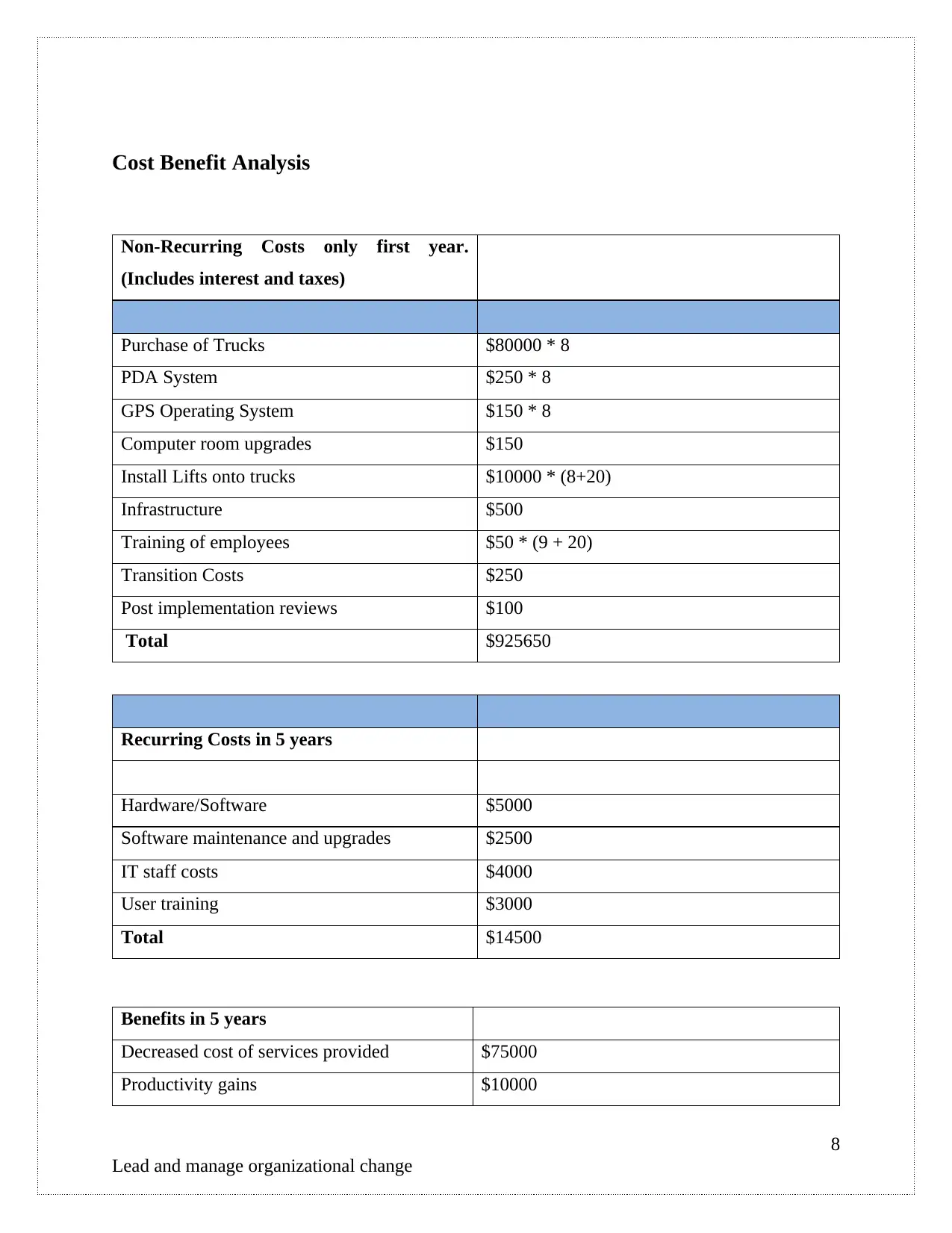
Cost Benefit Analysis
Non-Recurring Costs only first year.
(Includes interest and taxes)
Purchase of Trucks $80000 * 8
PDA System $250 * 8
GPS Operating System $150 * 8
Computer room upgrades $150
Install Lifts onto trucks $10000 * (8+20)
Infrastructure $500
Training of employees $50 * (9 + 20)
Transition Costs $250
Post implementation reviews $100
Total $925650
Recurring Costs in 5 years
Hardware/Software $5000
Software maintenance and upgrades $2500
IT staff costs $4000
User training $3000
Total $14500
Benefits in 5 years
Decreased cost of services provided $75000
Productivity gains $10000
8
Lead and manage organizational change
Non-Recurring Costs only first year.
(Includes interest and taxes)
Purchase of Trucks $80000 * 8
PDA System $250 * 8
GPS Operating System $150 * 8
Computer room upgrades $150
Install Lifts onto trucks $10000 * (8+20)
Infrastructure $500
Training of employees $50 * (9 + 20)
Transition Costs $250
Post implementation reviews $100
Total $925650
Recurring Costs in 5 years
Hardware/Software $5000
Software maintenance and upgrades $2500
IT staff costs $4000
User training $3000
Total $14500
Benefits in 5 years
Decreased cost of services provided $75000
Productivity gains $10000
8
Lead and manage organizational change
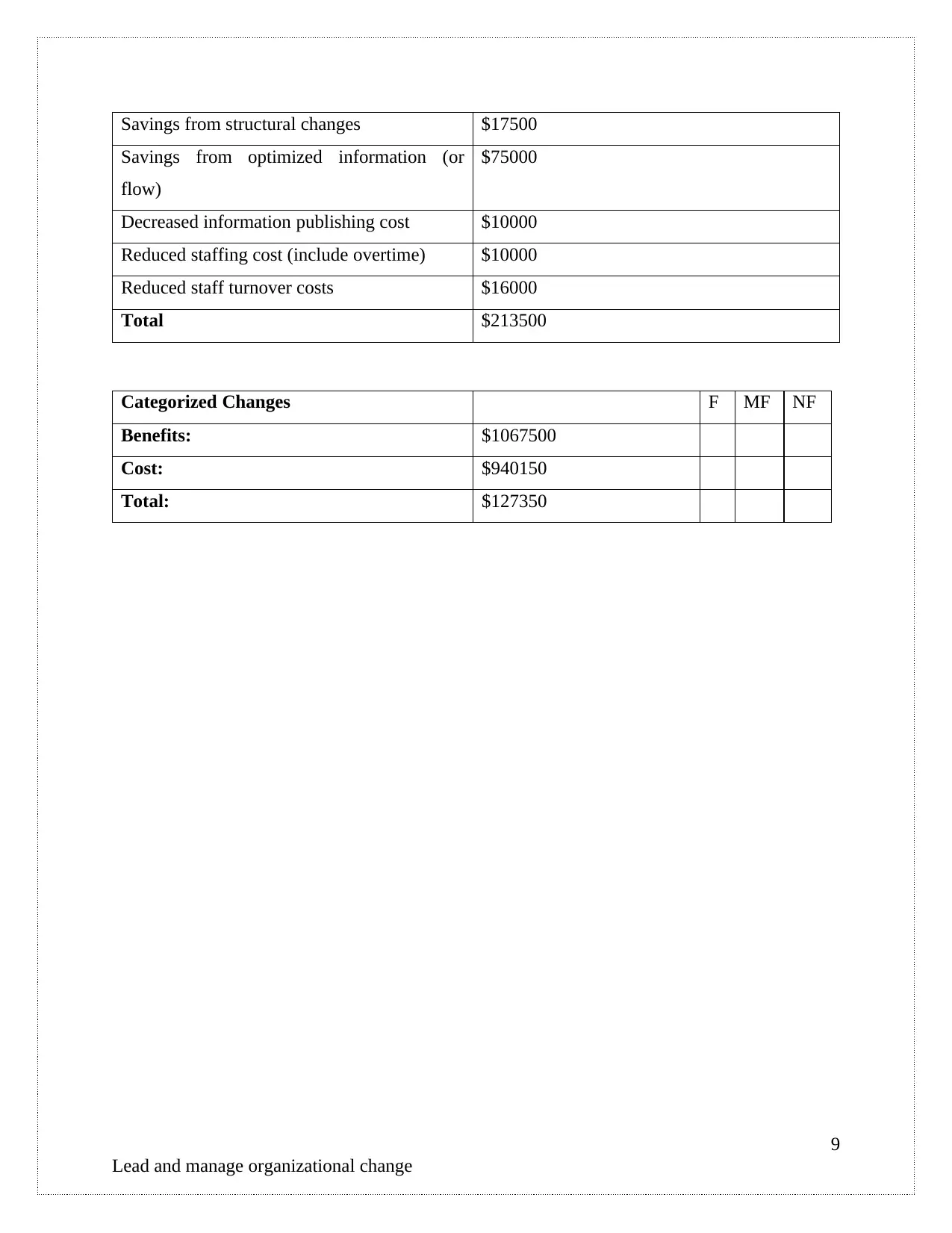
Savings from structural changes $17500
Savings from optimized information (or
flow)
$75000
Decreased information publishing cost $10000
Reduced staffing cost (include overtime) $10000
Reduced staff turnover costs $16000
Total $213500
Categorized Changes F MF NF
Benefits: $1067500
Cost: $940150
Total: $127350
9
Lead and manage organizational change
Savings from optimized information (or
flow)
$75000
Decreased information publishing cost $10000
Reduced staffing cost (include overtime) $10000
Reduced staff turnover costs $16000
Total $213500
Categorized Changes F MF NF
Benefits: $1067500
Cost: $940150
Total: $127350
9
Lead and manage organizational change
⊘ This is a preview!⊘
Do you want full access?
Subscribe today to unlock all pages.

Trusted by 1+ million students worldwide
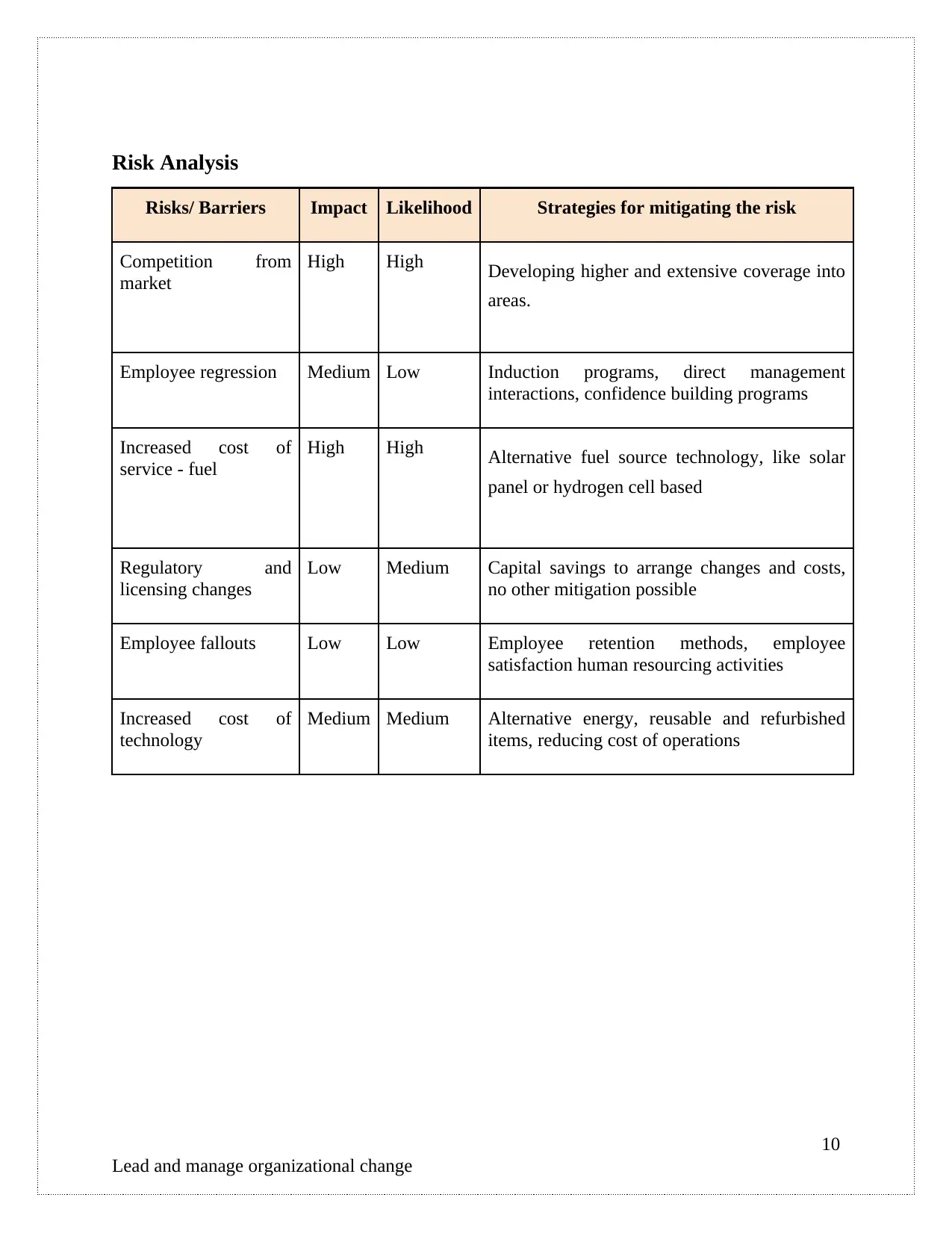
Risk Analysis
Risks/ Barriers Impact Likelihood Strategies for mitigating the risk
Competition from
market
High High Developing higher and extensive coverage into
areas.
Employee regression Medium Low Induction programs, direct management
interactions, confidence building programs
Increased cost of
service - fuel
High High Alternative fuel source technology, like solar
panel or hydrogen cell based
Regulatory and
licensing changes
Low Medium Capital savings to arrange changes and costs,
no other mitigation possible
Employee fallouts Low Low Employee retention methods, employee
satisfaction human resourcing activities
Increased cost of
technology
Medium Medium Alternative energy, reusable and refurbished
items, reducing cost of operations
10
Lead and manage organizational change
Risks/ Barriers Impact Likelihood Strategies for mitigating the risk
Competition from
market
High High Developing higher and extensive coverage into
areas.
Employee regression Medium Low Induction programs, direct management
interactions, confidence building programs
Increased cost of
service - fuel
High High Alternative fuel source technology, like solar
panel or hydrogen cell based
Regulatory and
licensing changes
Low Medium Capital savings to arrange changes and costs,
no other mitigation possible
Employee fallouts Low Low Employee retention methods, employee
satisfaction human resourcing activities
Increased cost of
technology
Medium Medium Alternative energy, reusable and refurbished
items, reducing cost of operations
10
Lead and manage organizational change
Paraphrase This Document
Need a fresh take? Get an instant paraphrase of this document with our AI Paraphraser
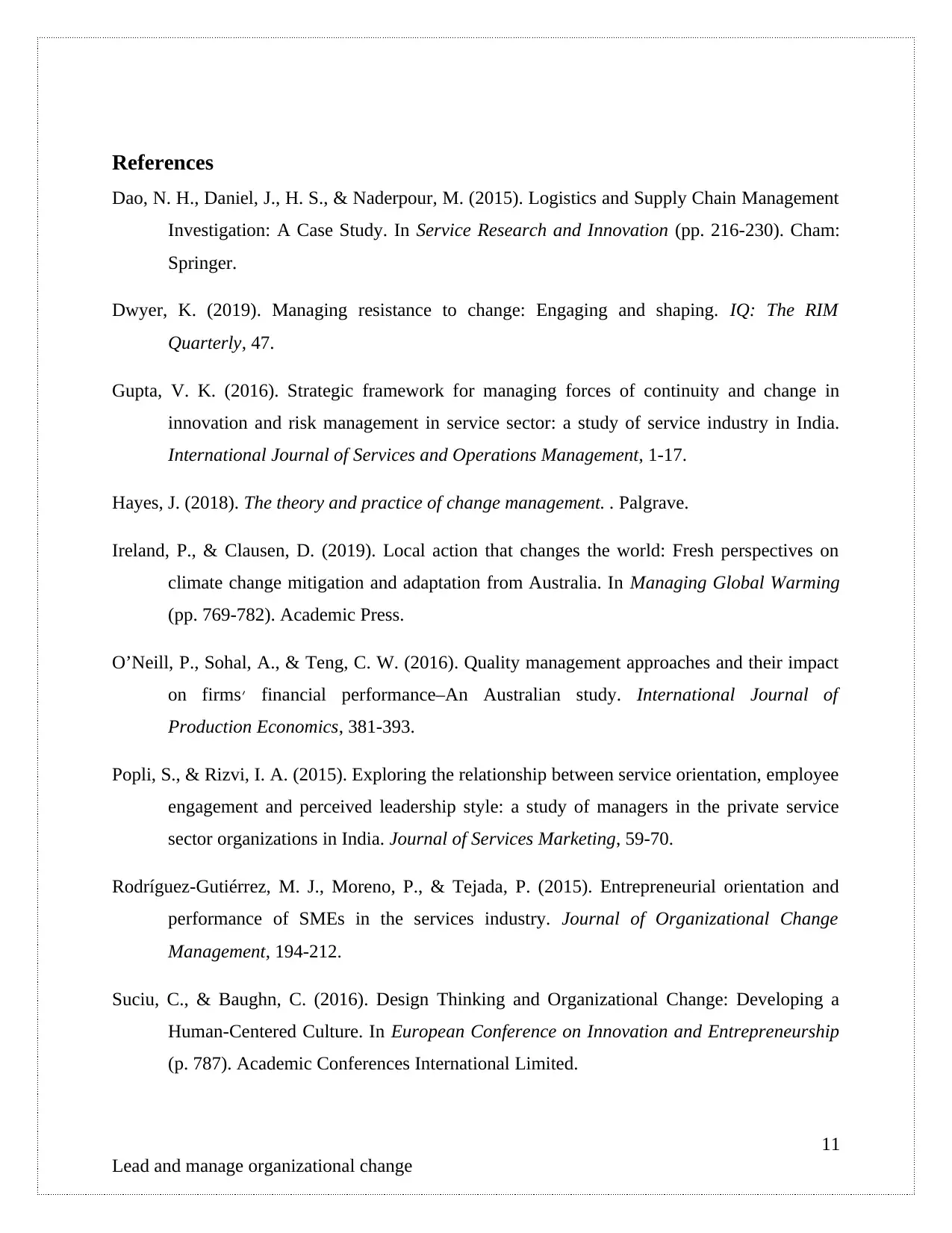
References
Dao, N. H., Daniel, J., H. S., & Naderpour, M. (2015). Logistics and Supply Chain Management
Investigation: A Case Study. In Service Research and Innovation (pp. 216-230). Cham:
Springer.
Dwyer, K. (2019). Managing resistance to change: Engaging and shaping. IQ: The RIM
Quarterly, 47.
Gupta, V. K. (2016). Strategic framework for managing forces of continuity and change in
innovation and risk management in service sector: a study of service industry in India.
International Journal of Services and Operations Management, 1-17.
Hayes, J. (2018). The theory and practice of change management. . Palgrave.
Ireland, P., & Clausen, D. (2019). Local action that changes the world: Fresh perspectives on
climate change mitigation and adaptation from Australia. In Managing Global Warming
(pp. 769-782). Academic Press.
O’Neill, P., Sohal, A., & Teng, C. W. (2016). Quality management approaches and their impact
on firms׳ financial performance–An Australian study. International Journal of
Production Economics, 381-393.
Popli, S., & Rizvi, I. A. (2015). Exploring the relationship between service orientation, employee
engagement and perceived leadership style: a study of managers in the private service
sector organizations in India. Journal of Services Marketing, 59-70.
Rodríguez-Gutiérrez, M. J., Moreno, P., & Tejada, P. (2015). Entrepreneurial orientation and
performance of SMEs in the services industry. Journal of Organizational Change
Management, 194-212.
Suciu, C., & Baughn, C. (2016). Design Thinking and Organizational Change: Developing a
Human-Centered Culture. In European Conference on Innovation and Entrepreneurship
(p. 787). Academic Conferences International Limited.
11
Lead and manage organizational change
Dao, N. H., Daniel, J., H. S., & Naderpour, M. (2015). Logistics and Supply Chain Management
Investigation: A Case Study. In Service Research and Innovation (pp. 216-230). Cham:
Springer.
Dwyer, K. (2019). Managing resistance to change: Engaging and shaping. IQ: The RIM
Quarterly, 47.
Gupta, V. K. (2016). Strategic framework for managing forces of continuity and change in
innovation and risk management in service sector: a study of service industry in India.
International Journal of Services and Operations Management, 1-17.
Hayes, J. (2018). The theory and practice of change management. . Palgrave.
Ireland, P., & Clausen, D. (2019). Local action that changes the world: Fresh perspectives on
climate change mitigation and adaptation from Australia. In Managing Global Warming
(pp. 769-782). Academic Press.
O’Neill, P., Sohal, A., & Teng, C. W. (2016). Quality management approaches and their impact
on firms׳ financial performance–An Australian study. International Journal of
Production Economics, 381-393.
Popli, S., & Rizvi, I. A. (2015). Exploring the relationship between service orientation, employee
engagement and perceived leadership style: a study of managers in the private service
sector organizations in India. Journal of Services Marketing, 59-70.
Rodríguez-Gutiérrez, M. J., Moreno, P., & Tejada, P. (2015). Entrepreneurial orientation and
performance of SMEs in the services industry. Journal of Organizational Change
Management, 194-212.
Suciu, C., & Baughn, C. (2016). Design Thinking and Organizational Change: Developing a
Human-Centered Culture. In European Conference on Innovation and Entrepreneurship
(p. 787). Academic Conferences International Limited.
11
Lead and manage organizational change
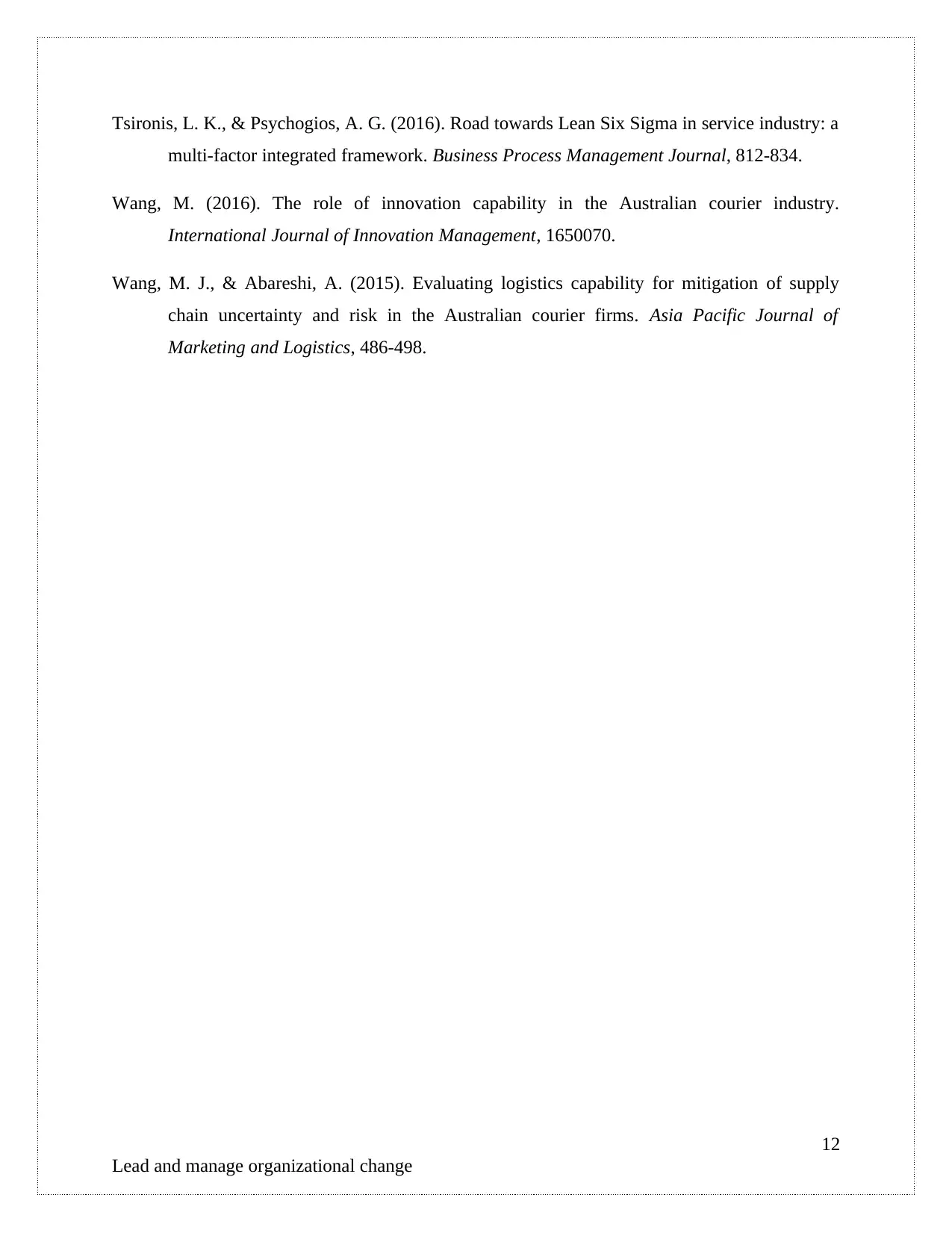
Tsironis, L. K., & Psychogios, A. G. (2016). Road towards Lean Six Sigma in service industry: a
multi-factor integrated framework. Business Process Management Journal, 812-834.
Wang, M. (2016). The role of innovation capability in the Australian courier industry.
International Journal of Innovation Management, 1650070.
Wang, M. J., & Abareshi, A. (2015). Evaluating logistics capability for mitigation of supply
chain uncertainty and risk in the Australian courier firms. Asia Pacific Journal of
Marketing and Logistics, 486-498.
12
Lead and manage organizational change
multi-factor integrated framework. Business Process Management Journal, 812-834.
Wang, M. (2016). The role of innovation capability in the Australian courier industry.
International Journal of Innovation Management, 1650070.
Wang, M. J., & Abareshi, A. (2015). Evaluating logistics capability for mitigation of supply
chain uncertainty and risk in the Australian courier firms. Asia Pacific Journal of
Marketing and Logistics, 486-498.
12
Lead and manage organizational change
⊘ This is a preview!⊘
Do you want full access?
Subscribe today to unlock all pages.

Trusted by 1+ million students worldwide
1 out of 12
Related Documents
Your All-in-One AI-Powered Toolkit for Academic Success.
+13062052269
info@desklib.com
Available 24*7 on WhatsApp / Email
![[object Object]](/_next/static/media/star-bottom.7253800d.svg)
Unlock your academic potential
Copyright © 2020–2025 A2Z Services. All Rights Reserved. Developed and managed by ZUCOL.




